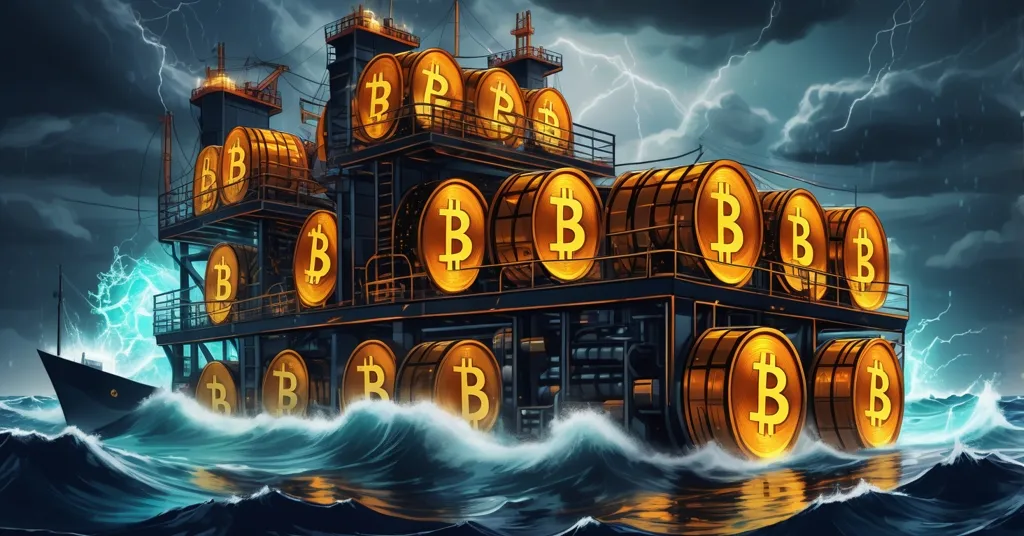OPEC+ Supply Surge and Trump Tariff Delays: Impact on Bitcoin Mining Costs

OPEC’s Supply Surge and Trump’s Tariff Delay: Ripple Effects for Bitcoin and Crypto
Saudi Arabia and OPEC+ are shaking up global energy markets with a bold price hike and a massive supply increase, just as geopolitical storms brew with Trump’s tariff delays and Red Sea attacks. While oil markets teeter on a tightrope, the crypto world—especially Bitcoin miners—could feel the tremors through energy costs and broader economic uncertainty. Let’s unpack how these moves intersect with the decentralized revolution.
- Saudi Arabia’s Aramco hikes Arab Light crude price by $1 per barrel, setting a $2.20 premium for Asian buyers.
- OPEC+ boosts oil supply by 548,000 barrels per day in August, eyeing more in September.
- Trump delays tariffs to August 1, while Houthi attacks in the Red Sea spike supply risks, potentially impacting Bitcoin mining costs.
OPEC+ Bets Big on Supply and Price Hikes
Let’s get down to brass tacks. Saudi Arabia, through its state-owned behemoth Aramco, has bumped up the price of Arab Light crude by a full dollar per barrel, now sitting at a $2.20 premium above the regional benchmark for Asian buyers starting in August. For the uninitiated, crude oil grades like Arab Light are benchmark products that set pricing trends for global markets, and a “premium” means buyers pay extra over a standard index due to perceived quality or demand. This hike was a gut punch to expectations—traders and refiners surveyed by Bloomberg were bracing for a more modest 65-cent increase. It’s a clear signal of confidence that the market can stomach higher costs without buckling, as detailed in this analysis of Saudi Aramco’s pricing decision.
Simultaneously, OPEC+, the alliance of oil-producing nations including Saudi Arabia and Russia, is turning on the taps. They’ve agreed to pump an extra 548,000 barrels per day (bpd—a standard measure of daily oil production) into the market in August, a sharper rise than the 411,000 bpd increments seen from May to July. There’s talk of another 548,000 bpd boost in September, pending their August 3 meeting. This isn’t pocket change; it’s a strategic push to reclaim market share from non-OPEC players like U.S. shale producers, timed with peak summer demand when Northern Hemisphere drivers—think U.S. July 4th road trips—guzzle fuel like there’s no tomorrow. Oil prices have responded, nudging past $67 per barrel, with Brent crude hitting $69.72 recently (per Oilprice.com data from July 7, 2025), though it’s floated as high as $80 in prior weeks.
Ole Hansen, Head of Commodity Strategy at Saxo Bank, captured the mood:
“The decision to raise prices during the peak summer demand season signals that physical markets remain tight, suggesting the additional barrels can be absorbed… for now.”
That “for now” is the kicker. The physical market—where actual oil changes hands versus futures speculation—is tight, meaning demand currently matches or exceeds supply. But Robert Rennie from Westpac throws in a reality check:
“OPEC+ is clearly taking advantage of a period of tightness in global energy markets, but seasonal demand is expected to fade soon.”
If summer demand dips and OPEC+ keeps flooding the market, prices could nosedive. Analysts at FGE (via Reuters) even hint that actual output hikes might fall short due to capacity constraints in countries like Iraq and Kazakhstan, despite the headline numbers. OPEC+’s own statement leans on a “steady global economic outlook and current healthy market fundamentals,” betting that giants like China and the U.S. will keep slurping up oil. Historically, though, their market-share gambles—like the 2014-2016 price war—have backfired with oversupply crashes. For now, they’re rolling the dice, reversing nearly 80% of the 2.2 million bpd voluntary cuts made by eight member nations, per RBC Capital insights. More on this strategy can be found in this report on OPEC+ supply increases for 2025.
Geopolitical Wildcards: Tariffs and Red Sea Chaos
Zoom out, and the plot thickens with geopolitical noise. U.S. President Donald Trump has pushed a critical tariff deadline from July 9 to August 1, giving Europe a momentary breather but keeping markets on edge. These tariffs, part of Trump’s trade war saga since 2018, could stifle global growth if fully enacted, indirectly curbing oil demand as economies slow. Treasury Secretary Scott Bessent’s tease of imminent trade announcements (per Reuters) only fuels the uncertainty. Priyanka Sachdeva from Phillip Nova nails the sentiment:
“Concerns over Trump’s tariffs continue to be the broad theme in the second half of 2025, with dollar weakness the only support for oil for now.”
Then there’s the Middle East, where Yemen’s Houthi rebels—backed by Iran, according to Reuters—have reignited fears with attacks on merchant ships in the Red Sea. Two strikes on July 6-7, 2025, targeted Greek-managed vessels, with one ship, the Eternity C, reportedly sinking, leaving crew injured or missing (per Oilprice.com). The Red Sea, linked to the Gulf of Aden via the narrow Bab el-Mandeb strait, is a vital artery for global oil shipments. Disruptions here aren’t new—think Arab Spring chaos or 2018 Houthi strikes—but this is the first major incident since December. Insurance premiums for vessels are spiking, and with Israeli-Iranian tensions simmering (including speculation of U.S.-backed strikes on Iran’s nuclear sites, per Oilprice.com), traders might soon price in serious supply risks. For now, OPEC+’s supply cushion keeps panic at bay, but history shows these flare-ups can jolt oil markets overnight. Recent updates on these incidents are covered in this piece about Houthi attacks in the Red Sea.
Energy Costs and Bitcoin Mining: A Hidden Link
So, why should crypto enthusiasts care about oil barrels and trade spats? Simple: energy costs. Bitcoin mining, the process of validating transactions on the network by solving complex mathematical puzzles, is notoriously power-hungry. According to the Cambridge Bitcoin Electricity Consumption Index, the network consumes more electricity annually than some mid-sized countries. In regions where electricity grids rely heavily on fossil fuels—think parts of China, Kazakhstan, or even the U.S.—oil price swings directly influence power costs. A sustained spike from Red Sea disruptions could hike operational expenses for miners, squeezing profitability unless they’ve locked in cheap power deals. Insights into this dynamic are discussed in this thread on oil price impacts on Bitcoin.
Conversely, if OPEC+ oversaturates the market and prices crash—as happened during the 2014-2016 oil glut—miners might catch a break with lower energy bills. Dennis Kissler from BOK Financial notes that “stronger demand is remaining above expectations,” suggesting OPEC+ might balance supply and demand for now, keeping prices stable. But if Rennie’s warning of fading seasonal demand proves true, a price drop could be a quiet win for energy-intensive crypto operations. Let’s not get starry-eyed, though. Even a temporary oil price crash won’t solve mining’s long-term energy problem—volatility is the real enemy, making cost forecasting a nightmare for large-scale miners. Community perspectives on this can be found in this Reddit discussion on Bitcoin mining and oil costs.
There’s another angle: hardware supply chains. Mining rigs, often manufactured in Asia and shipped globally, pass through trade routes like the Red Sea. Houthi attacks and rising shipping costs could delay deliveries or inflate prices for ASICs (specialized mining hardware), hitting miners’ expansion plans. Trump’s tariff shenanigans add another layer—if trade wars escalate, import costs for mining gear could spike, especially for U.S.-based operations. These are indirect hits, sure, but in a hyper-competitive space where every satoshi counts, they sting. The broader impact of such disruptions is explored in this analysis of Red Sea crises on supply chains and energy.
Decentralization’s Edge in a Centralized Mess
Step back, and this oil market drama is a glaring reminder of why Bitcoin and decentralized systems matter. OPEC+’s supply games, Trump’s tariff tantrums, and Middle East chaos are textbook examples of centralized control over critical resources and economies. Oil prices don’t just affect gas pumps; they ripple through inflation, growth, and fiat stability—systems Bitcoin was built to sidestep. For maximalists, this is the ultimate “told you so.” When fiat currencies wobble under geopolitical strain, decentralized money offers a hedge, a middle finger to the chaos of state-driven markets. Historical parallels to such economic impacts on crypto are covered in this piece on oil price crashes and cryptocurrency effects.
But let’s play devil’s advocate. OPEC+’s aggressive supply push could be reckless—history screams oversupply risks, and a price collapse might hurt oil-dependent economies more than it helps miners. Centralized resource control isn’t just OPEC’s sin; it’s a structural flaw Bitcoin can’t fully escape while miners rely on grid power tied to fossil fuels. And while Bitcoin shines as a hedge, altcoins and other blockchains like Ethereum might carve niches here too. DeFi projects on Ethereum, for instance, are exploring tokenized energy markets and funding renewable solutions for mining—think Powerledger or Energy Web Token. These aren’t Bitcoin’s domain, but they’re part of the broader push for sustainability that oil volatility might accelerate.
One counterpoint worth chewing on: could sustained oil chaos fast-track crypto mining’s shift to renewables? Past price spikes have pushed industries toward solar and wind; Bitcoin miners, under cost pressure, might follow suit. Projects like Square and Tesla’s solar-powered mining initiatives are early signals. If Red Sea tensions or OPEC+ missteps keep energy costs erratic, the “effective accelerationism” ethos—pushing tech innovation hard and fast—could see miners pivot to greener grids sooner than expected. It’s not a sure bet, but it’s a possibility that aligns with disrupting the status quo. Updates on related economic shifts can be tracked via this report on OPEC supply moves and tariff delays.
Key Takeaways and Questions for the Crypto Crowd
- Why is OPEC+ ramping up oil supply, and what’s the scale?
They’re capitalizing on peak summer demand to regain market share, increasing supply by 548,000 barrels per day in August, with a potential repeat in September, though capacity issues might limit the real impact. - What does Saudi Arabia’s crude price hike mean for markets?
The $1 per barrel increase to a $2.20 premium signals confidence in tight demand, pushing oil prices up to $67-69 per barrel, but risks oversupply if summer demand fades. - How do Trump’s tariff delays affect the economic backdrop for crypto?
Pushing tariffs to August 1 eases short-term trade tensions, but lingering uncertainty could slow global growth, potentially positioning Bitcoin as a hedge against fiat weakness. - What risks do Red Sea attacks pose to crypto operations?
Houthi strikes on shipping lanes raise oil supply disruption fears, potentially hiking energy costs for Bitcoin mining and delaying hardware shipments through critical trade routes. - Could oil market volatility benefit or harm Bitcoin miners?
A price spike could raise mining energy costs, squeezing margins, while a crash from oversupply might lower bills—though volatility itself makes planning a gamble. - Might this chaos push crypto toward renewable energy?
Persistent oil price swings could accelerate miners’ shift to solar or wind, aligning with decentralization’s disruptive ethos and projects already exploring sustainable blockchain solutions.
Peering deeper, the oil market’s high-stakes chess game isn’t just about barrels—it’s about power, control, and the fragility of centralized systems. For Bitcoiners, every OPEC+ misstep or geopolitical flare-up is another crack in the fiat facade, reinforcing why decentralized money isn’t a fad but a necessity. Yet, we can’t ignore the practical bind: miners are tethered to energy grids still dominated by fossil fuels. A Red Sea escalation could be a double-edged sword, jacking up costs while spotlighting crypto’s resilience. On the flip side, if OPEC+ floods the market and tanks prices, miners might smirk at cheaper power, but global economic fallout could drag crypto markets down with fiat woes.
Let’s not pretend to have a crystal ball—shameless price predictions are a scam we won’t peddle. Instead, keep your eyes peeled on how this energy saga unfolds. It’s not just oil at stake; it’s the bottom line for Bitcoin’s hash rate, the push for sustainable mining, and the broader narrative of decentralization dodging yet another mess made by suits and sheikhs. The game’s moving fast, and crypto’s got skin in it, whether we like it or not. Stay sharp.



